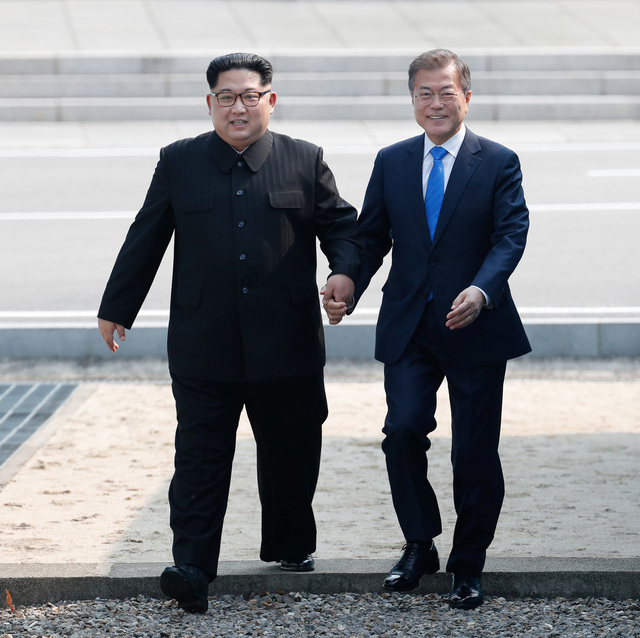 |
|
South Korean President Moon Jae-in (right) and North Korean leader Kim Jong-un cross the Military Demarcation Line (MDL) together ahead of the Inter-Korean Summit in Panmunjeom on Apr. 27. (Blue House photo pool)
|
Argues that advances in inter-Korean relations improve environment for denuclearization
“Advancing inter-Korean relations is not a secondary effect from achieving progress in North Korea-US relations. Rather, it is advancement in inter-Korean relations that provides the energy promoting the denuclearization of the Korean Peninsula.” These two sentences represented the key message in terms of the Korean Peninsula’s political situation in President Moon Jae-in’s celebratory address for the 73th National Liberation Day holiday on Aug. 15. It was his response to the US State Department, which argued after the announcement of South and North Korea’s agreement to hold a Pyongyang summit in September that improvements in inter-Korean relations “cannot advance separately from resolving North Korea's nuclear program.” It also strongly stated his commitment to using advancements in inter-Korean relations as a way of driving denuclearization. “This is borne out by our historical experience: when inter-Korean relations were good in the past, the North Korean nuclear threat diminished and we were able to achieve a denuclearization agreement,” he noted. Stating his firm commitment to using advancements in inter-Korean relations to achieve a political breakthrough, President Moon presented comprehensive and multilayered suggestions including a vision for shared South and North Korean prosperity and the means of achieve it, plans for a Pyongyang summit in the fall, and ideas for Northeast Asian security cooperation. Underlying all of this was an understanding that North Korean denuclearization can only be achieved in reality within the context of a comprehensive peace process. “Even if political reunification remains far away, true ‘liberation’ for us comes through establishing peace between South and North, freely coming and going and estimating a single economic community,” President Moon stated, presenting shared prosperity as the “dream of a peace economy and an economic community.” Notably, President Moon stressed a “commitment to practically realizing this grand vision by presenting a concrete timetable for inter-Korean cooperation projects,” said former Minister of Unification Lee Jong-seok. Announcing that the joint inter-Korean liaison office at Kaesong specified in the Apr. 27 Panmunjeom Declaration would be opened “in a few days,” President Moon called it a “very meaningful event” ushering in an “era of communication between South and North 24 hours a day, 365 days a year.” He also said it would be “developed into a mutual mission going ahead.” Says groundbreaking ceremony for railway project will be “within the year” On the matter of railway and road cooperation projects, he announced a target of “holding a groundbreaking ceremony within the year.” The specifying of a deadline for the ceremony – “within the year” – is crucial. Railway and road cooperation is a key foundation for the two sides to proceed toward “reconnect[ing] the blood relations of the people and bring[ing] forward the future of co-prosperity” as stated in item 1 of the Panmunjeom Declaration – but has remained at the level of joint investigation and research, stymied by the UN and US’s North Korea sanctions. The problem may be better understood in connection with President Moon’s proposal of an “East Asian railway community joining the six countries of East Asia [South and North Korea, China, Japan, Russia, and Mongolia] and the US,” which he unveiled on Aug. 15. President Moon noted that the European Coal and Steel Community, which is seen as laying the groundwork for peace in Europe after the Second World War, was the “origin of the European Union.” Converting the means of war into a path for peace Where the countries of Europe opted to proceed on the path toward peace by sharing the strategic items (coal and steel) that had previously provided war material, President Moon’s vision for East Asia involves paving the way for peace in the form of cooperation and security through the sharing of railways, which represented the key means of transport for the militaries that devastated the region in the late 19th and early 20th centuries. Also worthy of attention is President Moon’s mention of “resuming [operations at] the Kaesong Industrial Complex and tourism at Mt. Keumgang.” His references to resumptions were prefaced by remarks about “full-scale economic cooperation [being] only achieved once peace is established on the Korean Peninsula with complete denuclearization” and “state research institution studies predict[ing] the economic effects from inter-Korean economic cooperation could total at least 170 trillion won [US$150 billion] over the next 30 years.” He also presented an expanded version of the Kaesong Complex and Mt. Keumgang projects with a vision for establishing a “special unification economic zone” on the Gyeonggi/Gangwon Province border region, provided that “military tensions are reduced and peace is established.” By presenting resumption of operations at Kaesong and Mt. Keumgang and the realization of an even larger vision for economic cooperation as tasks – albeit in general terms – he sent a message to North Korea stressing his commitment to full-scale economic cooperation, while effectively calling on Pyongyang to hasten its denuclearization measures to achieve it. President Moon further pledged that his planned visit to Pyongyang for a summit this September would be an occasion for “confirming implementation of the Panmunjeom declaration between leaders and taking a bold step toward a [Korean] war-ending declaration and peace agreement along with complete denuclearization of the Korean Peninsula.” He went on to say the two sides would work to “establish deeper trust between us” and “making leading efforts to promote denuclearization dialogue between North Korea and the US.” It was an important speech that conveyed a similarly decisive tone to President Moon’s July 2017 speech in Berlin. By Lee Je-hun, senior staff writer Please direct comments or questions to [english@hani.co.kr]






